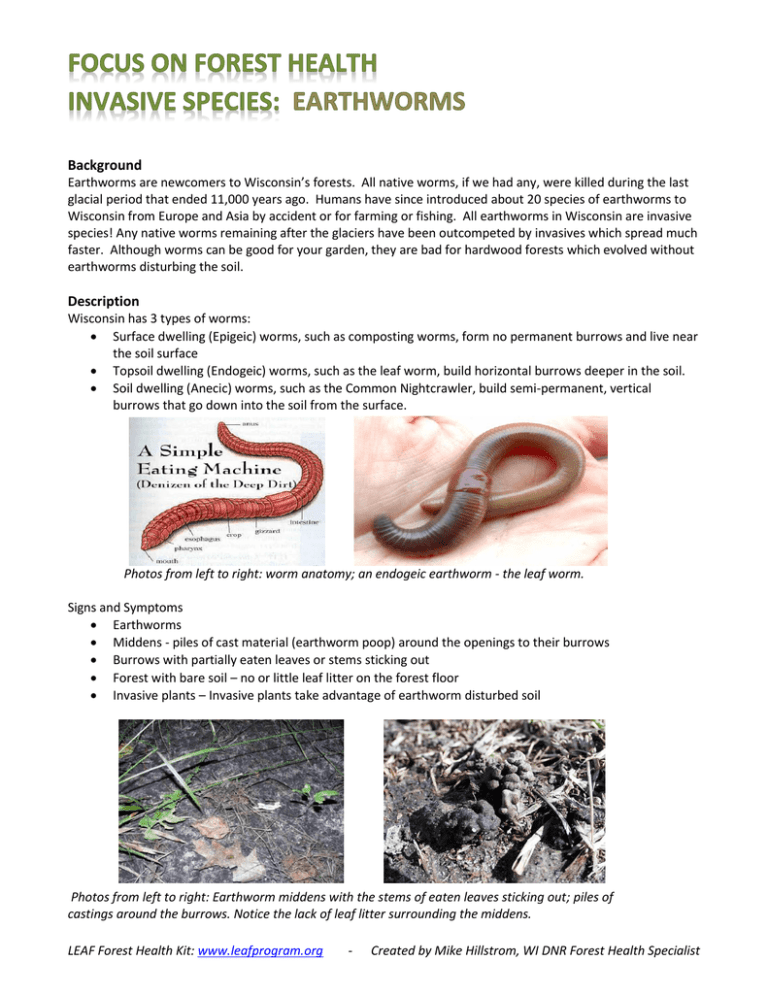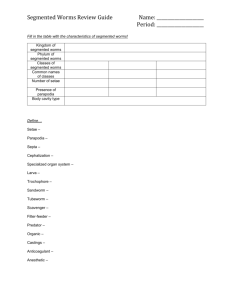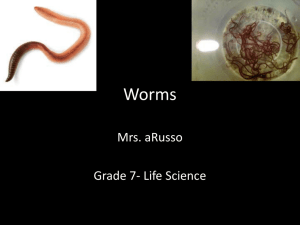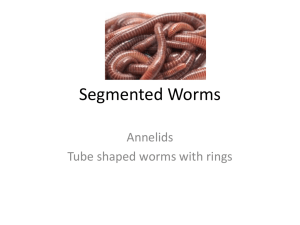Background
advertisement

Background Earthworms are newcomers to Wisconsin’s forests. All native worms, if we had any, were killed during the last glacial period that ended 11,000 years ago. Humans have since introduced about 20 species of earthworms to Wisconsin from Europe and Asia by accident or for farming or fishing. All earthworms in Wisconsin are invasive species! Any native worms remaining after the glaciers have been outcompeted by invasives which spread much faster. Although worms can be good for your garden, they are bad for hardwood forests which evolved without earthworms disturbing the soil. Description Wisconsin has 3 types of worms: Surface dwelling (Epigeic) worms, such as composting worms, form no permanent burrows and live near the soil surface Topsoil dwelling (Endogeic) worms, such as the leaf worm, build horizontal burrows deeper in the soil. Soil dwelling (Anecic) worms, such as the Common Nightcrawler, build semi-permanent, vertical burrows that go down into the soil from the surface. Photos from left to right: worm anatomy; an endogeic earthworm - the leaf worm. Signs and Symptoms Earthworms Middens - piles of cast material (earthworm poop) around the openings to their burrows Burrows with partially eaten leaves or stems sticking out Forest with bare soil – no or little leaf litter on the forest floor Invasive plants – Invasive plants take advantage of earthworm disturbed soil Photos from left to right: Earthworm middens with the stems of eaten leaves sticking out; piles of castings around the burrows. Notice the lack of leaf litter surrounding the middens. LEAF Forest Health Kit: www.leafprogram.org - Created by Mike Hillstrom, WI DNR Forest Health Specialist Habitat and Current Distribution Invasive earthworms are found in hardwood forests all around the state but earthworm free areas still exist. Surveys are being conducted to determine the species of worms present in Wisconsin and the distribution of each species. Impact and Management Earthworms are a major threat to Wisconsin’s forests. Ecological – When earthworms burrow and mix leaf litter and the soil, it is a major disturbance for Wisconsin forests. Healthy forests that evolved without earthworms depend upon fungi and invertebrates to slowly break down organic matter and gradually release nutrients back to the plants. Earthworms disrupt this normal breakdown of leaves. This is important because the leaf litter in a forest is comparable to the skin on an animal. The leaf litter retains moisture, protects the organs (roots), breathes, prevents erosion, deters pathogens (non-native plants), and promotes seed germination. Worms puncture the “skin” by eating leaf litter rapidly which exposes the soil, making it available to invasive plants, compaction, and run-off of rainwater, which would normally keep the soil moist. The disturbance also reduces the diversity of plants, insects and other species. Economic – Healthy forests are critical to Wisconsin’s economy. Forests with earthworms have few regenerating seedlings and often instead have invasive plants. This means that if a group of trees dies or is cut, there are no trees to replace them. Healthy stands have abundant seedlings and few costs, while sites with earthworms cost much more because foresters or landowners must pay to treat the invasive plants and establish seedlings. Social/recreational – Earthworms can be a benefit to humans when kept contained in composting piles, agriculture fields and gardens. But the same benefits they provide in human controlled landscapes have major costs in natural ecosystems. Keeping worms out of our forests will help keep them healthy for all of us to enjoy. While we don’t have a way of ridding the forests of worms once they are established, we can keep them from spreading to forests that are not yet invaded. You can help prevent invasive worms from spreading in Wisconsin by: Invasive worms enter the forest primarily through horticulture, agriculture, and recreation. o If you fish DO NOT dump your worms in the water, on the ground, or in the woods. Dispose of live worms in the trash. o If you plant trees and shrubs on your property examine the root balls for worms and destroy any you find. Wash your shoes and tire treads when you leave a site with earthworms so you do not spread them to the next forest you visit. For more information http://dnr.wi.gov/topic/Invasives/ http://www.nrri.umn.edu/worms/default.htm LEAF Forest Health Kit: www.leafprogram.org - Created by Mike Hillstrom, WI DNR Forest Health Specialist







